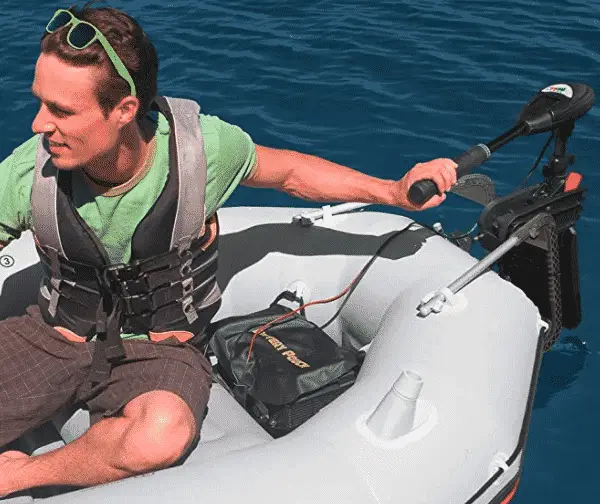How To Store A Kayak In A Garage – Different Options
Owning a kayak isn’t all just fun and games on the water. You have to figure out how to properly care, protect and store your new equipment. In this post we are going to cover how to store a kayak in a garage.
Not all garages are the same shape and size, what might be the best kayak storage method for one person, might not be the ideal solution for you.
Therefore, we are going to cover a few different kayak storage methods to suit a wide range of garages and needs.
Table of Contents
Why Store a Kayak in a Garage?
- Protects your kayak from damage and deformity
Storing your kayak properly indoors can prevent any damage from rough surfaces of deformation of the hull. - Keeps your kayak safe from the elements
UV damage, frost, heat, wind, and rain can all play havoc on your kayak, especially when it’s exposed for long periods of time. Storing your kayak in a garage can help to eradicate some of these worries. - Helps to prevent theft
Kayaks aren’t a cheap piece of kit. Some touring kayaks can creep up into the thousands of dollars. And if stored outside, it’s not impossible that someone could carry it out of your yard. - Prevents injury from improper storage
Some kayaks are heavy and upwards of 50lbs. The long shape and dimensions can make a kayak difficult to grab and handle. Proper storage racks will ensure your kayak is stored in the correct position and easy to mount/unmount.
Kayak Garage Storage Solutions
1. Wall Mounted Kayak Rack
Wall mounted kayak storage solutions are a great way to keep your kayaks elevated, out of the way and save on your floor space.
You will need plenty of wall space for this solution, especially if you are wanting to store 2 or more kayaks, but it’s definitely possible for most garages.
Make sure you leave enough room for your kayak door to open.
There is a whole bunch of affordable wall mounted kayak racks on Amazon, that will be fine for the job (see example below).
Alternatively, you can DIY your own, using simple materials like wood, wall brackets and PVC pipes and pool noodles. Or any other materials you think will be well suited.
Ensure that the rack mounts are padded in someway. This will prevent any damage being caused to the hull of your kayak over the long-term.
2. Wall Mounted Sling System
Very similar to a fixed wall rack, the sling system suspends your kayaks off the floor and against the wall – saving you a lot of floor space.
The biggest benefit of the sling system is that it can be easily moved. If your straps are wrapped around a ceiling beam, or hung on two small hooks, it’s not difficult to move the slings as opposed to a fixed wall rack.
Another benefit of slings is that they take up much less room in your garage when your kayaks aren’t in use.
The only downside to a sling/strap kayak storage solution is that if you have a larger or heavier kayak, it can be difficult to loosen the straps and remove the kayak on your own.
You can see a good example of a kayak sling on Amazon below.
3. Ceiling Kayak Storage
Our third option for kayak garage storage is an overhead sling suspension system or an overhead ceiling rack.
Sling suspension systems not only take up less space in your garage and allow you to use a space that otherwise would be wasted, but they are also much easier to mount the kayak than other systems.
How to hang a kayak in garage:
You simply rest the kayak on the floor below the pulleys and wrap the slings around the kayak’s hull (at least one at the bow, and one at the stern). You can hoist the kayak into the air and fix it in position.
This means that an overhead suspension system is great for heavier kayaks and solo paddlers.
Another form of ceiling storage is a ceiling-mounted kayak rack, that looks fairly similar to a wall rack, in that you slide the kayak into place behind a set of hooks/steel arms.
The only downside to a ceiling rack is that you will have to lift the kayak over your head to slide it into place, which if done alone, can easily hurt your back.
4. Freestanding Kayak Rack
Freestanding kayak racks are a great solution for anyone who doesn’t want a more permanent kayak storage solution in their garage.
With this form of kayak rack, the kayaks can be mounted in a variety of ways depending on what type you purchase or build.
You can store the kayaks on a horizontal rack (similar to wall-mounted racks) or a sling system (like wall-mounted slings), or even store the kayak upright on its end.
The biggest benefit of a freestanding rack is that it offers maneuverability. You can move and shift the rack around your garage if you need to.
You can also store the kayaks on the rack outside in the warmer and drier months of the year.
One downside of a freestanding kayak rack is that it tends to take up more room and floor space than any of the other solutions.
5. Portable Kayak Stands
Portable kayak stands are a great alternative solution to kayak garage storage. Whilst they might not be hard mounted to your walls or ceiling, they can provide a safe and secure platform to house your kayak.
The benefits of portable kayak stands is that they require no set-up or mounting within your garage. You can also take our stands anywhere with you, whether it be whilst you go kayak camping, or just for drying your kayak off outside.
If you have a busy garage that serves several purposes whether it be for tools, extra-storage, or a hobby of some kind. Kayak stands allow you to easily move your kayak around and out of your garage.
Many people who have more expensive or self-made wooden kayaks/canoes opt for a freestanding option as you run no risk of bumping the kayak on the floor, into your walls or ceiling whilst lifting the kayak into position.
6. DIY Kayak Garage Storage
When it comes to figuring out how to store a kayak in a garage you are by no means limited to the different options that you see online.
In fact, if you are handy with a few power tools, there is no reason why you couldn’t make a bespoke, sturdy and affordable kayak solution that works better for you and fits the dimensions of your garage.
Just ensure that the rack or slings can support the total capacity of your kayak, and that the surfaces your kayak will be slid onto are protected with foam, or rubber to protect your kayaks hull.
So, which is the best way to store a kayak in a garage?
Well, this is nearly impossible to answer for everyone and to decide you’ll have to take a look at the space you have available and make that decision yourself. Make sure to think hard about other items that’ll be in your garage e.g. cars, tools, storage boxes, etc.
If you have a smaller garage in which floor space is a premium, then a wall-mounted kayak rack or kayak sling storage system is probably the best option. They are simple to set up and offer protective storage for your kayak whilst keeping them off the floor and out of the way.
If you have a taller, but a narrow garage, you will probably need the wall space for shelves and other items. In this scenario, you’ll be best with a ceiling rack or ceiling sling.
Ceiling kayak racks are great for the seasonal paddler who only gets out a few times a year, or a solo paddler who struggles to lift the kayak into position on their own. Most people will mount their ceiling rack high enough so that the kayaks can suspend above a car.
If you have plenty of floor space, or might need to remove the kayaks on a regular basis for cleaning and drying or to use the garage for another purpose then a kayak storage system you can move is the best option.
If you only have one kayak, a set of kayak stands will do. If you need to mount 2 or more kayaks, then a freestanding rack is the best option, that can be easily slid/wheeled out of the garage when needed.
Kayak Garage Storage Tips
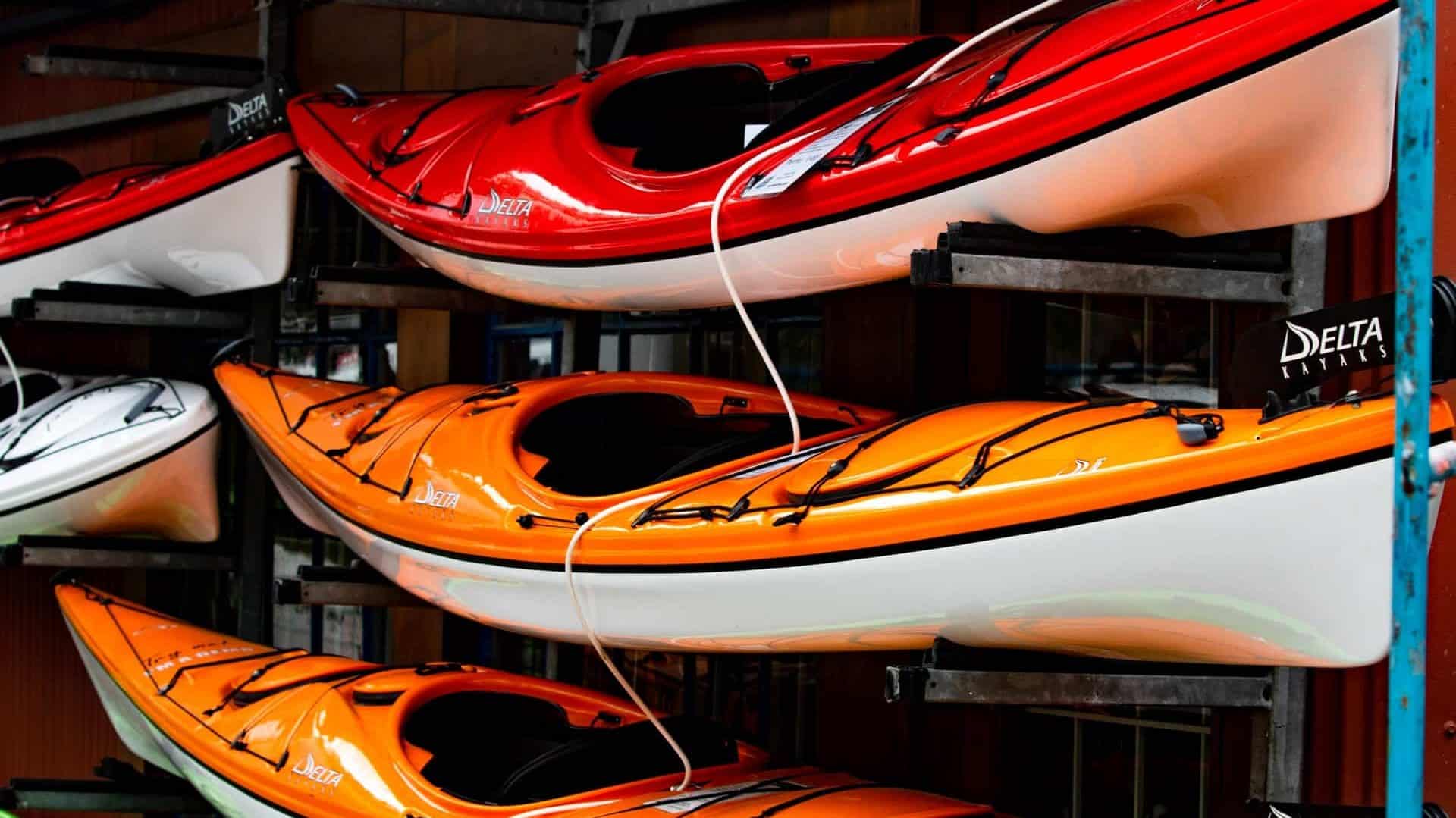
Temperature and Humidity For Kayak Storage
Storing your kayak indoors whether it be inside your house or garage is undoubtedly the best option in terms of protecting the kayak and giving it the longest lifespan possible.
However, garages aren’t insulated or heated in most homes, and therefore the temperature and humidity can fluctuate massively between seasons. I.e. freezing cold and damp in winter to overly hot and humid in summer.
Whilst most people will be fine in their garage year-round and kayaks will be better off inside than outdoors, there are a few considerations to be made with regards to the temperature and humidity of your garage.
High temperatures can lead to excessive humidity, which over time can cause your kayak to swell and deform. However, this only tends to happen in either direct sunlight or excessively high temperatures.
Cold temperatures tend to be better for kayaks, however, constant freezing and thawing of your kayak could lead to small cracks in the hull over a prolonged period of time. Although, most garages wont get cold enough to have items freeze on the inside.
Humidity can also be an accelerator for mold growth, especially on your kayak seat or other fabrics. To avoid this, ensure your kayak is completely cleaned and dried before storage.
If you find your garage becoming overly humid, especially once wet wetsuits, kayaks and PFDs have been stored, you can purchase a dehumidifier and run it a few times a week to keep the humidity levels down.
In the colder months, it’s impractical to run new central heating pipes into your garage just for a kayak. Instead, a small electric heater should be enough to keep the frost off your kayak.
Note: Most garages are fine, it’s best to test this out for yourself, if you suspect the garage is so cold or hot that it might cause damage, then it’s a simple problem to fix once the issue arises.
Clean and Dry Your Kayak Prior To Storage
Before you go ahead and lift your kayak into position or slide it on your rack, you should thoroughly clean and dry your kayak.
Mold build-up can be an issue with almost all water sports gear, especially if it is stored indoors. Mold will look unsightly and slowly deteriorate any fabrics e.g. your kayak seat.
Ensure that all areas of your kayak are dried to avoid any mold, and try to keep the humidity levels of your garage down.
To clean your kayak use the following steps as guidance:
- Remove all kayak accessories, such as seats, bungee straps, kayak coolers or kayak fishing crates. (You could machine or hand wash soft fabrics, depending on the manufacturers guidelines).
- Rinse most grime, and dirt off your kayak with a gentle stream of water (don’t scrub straight away, or any stones or grit could work its way into your hull and cause scratches).
- Once rinsed, use soap/mild detergent mixed with warm water, and a soft cloth or sponge to clean all easy to reach areas. Ensure to give your kayak a good scrub to remove all detritus.
- Once you have scrubbed the kayak, once again rinse, you can use a more powerful water setting here, as long as it wont damage any paint, wood or decals you might have on the kayak.
- Finally, empty the kayak of any water, and wipe dry with a towel. Leave the kayak outside in the sun for a couple of hours to fully dry if possible. Alternatively, bring it inside and ensure it’s dried a little more using the towel.
Final Words
Storing your kayak indoors is by far the best option to keep your kayak protected from the elements, from theft, and to make mounting and unmounting your kayak much easier.
Kayaks are expensive, and they should be looked after properly, especially to extend their lifespan. Kayak garage storage is just one part of that puzzle, coupled with regular maintenance and thorough cleaning, you might have a kayak for life!
We truly hope that this post has helped you answer how to store a kayak in a garage. There is a few options to choose from depending on your needs and spacial requirements.
Remember that purchasing a kayak garage storage solution is not always necessary. If you happen to be handy with a saw and drill, there is no reason why you can’t create your own kayak garage rack for a much cheaper price!

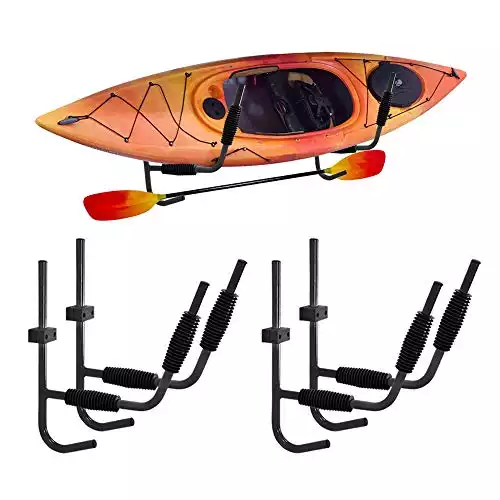
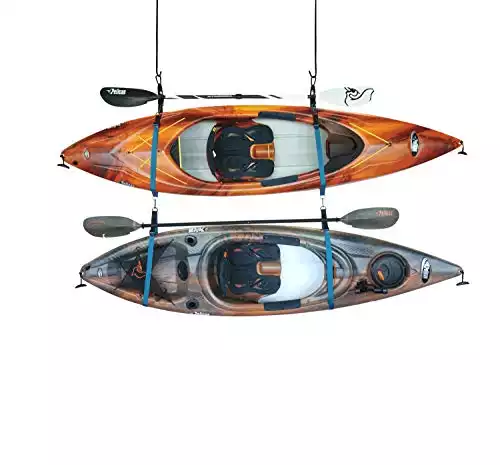
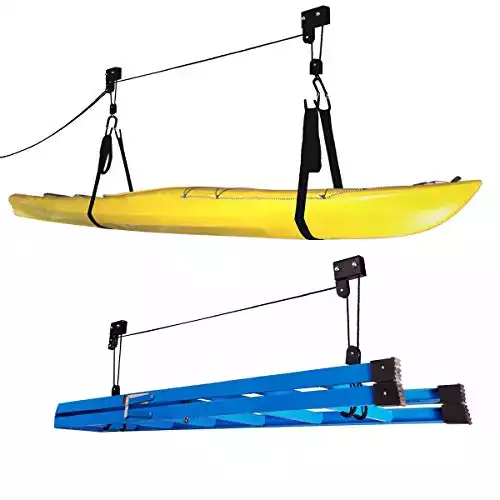
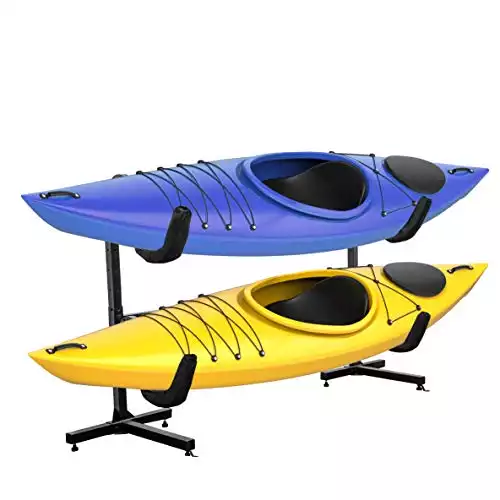
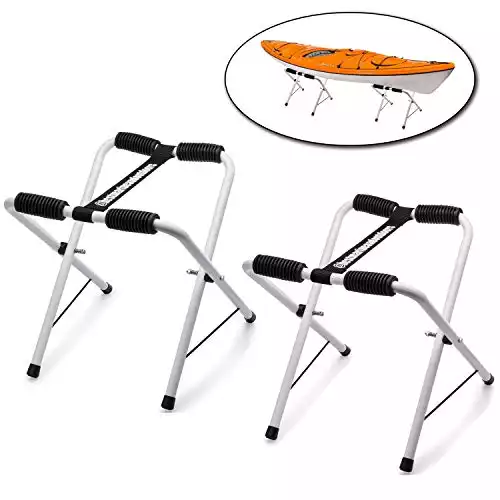
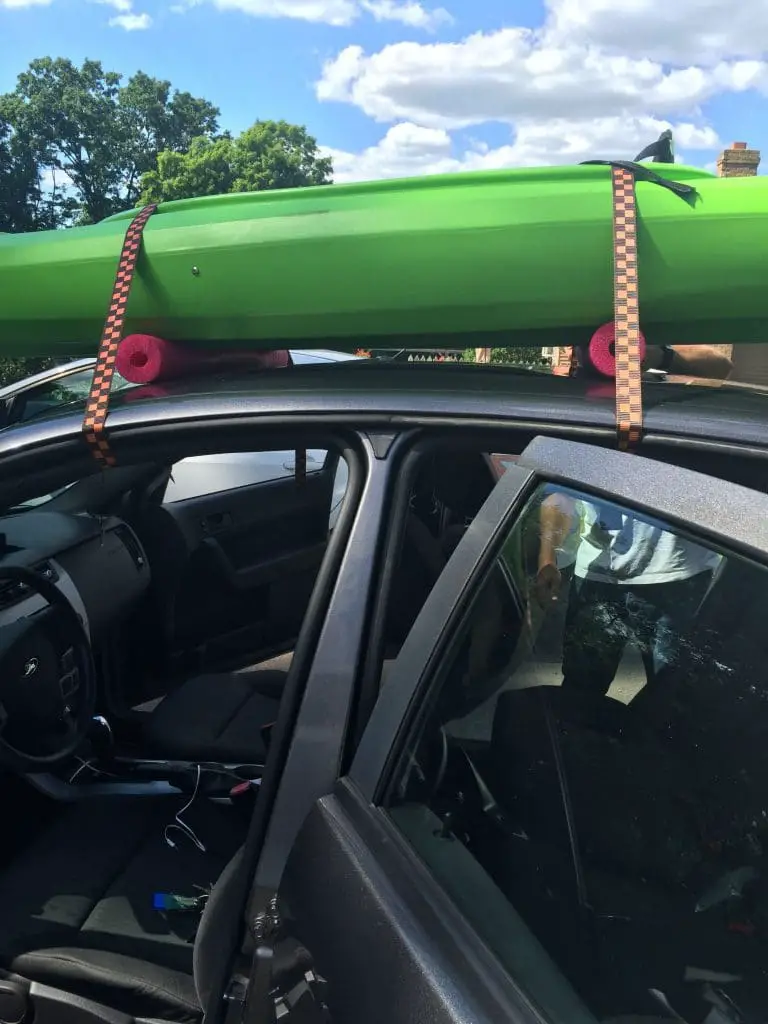

![Best Touring Kayaks in 2025 [8 Kayak Reviews & Buyers Guide]](https://watersportingadventure.com/wp-content/uploads/2020/02/person-sitting-on-teal-kayak-on-calm-water-of-river-3230581-2-1-768x512.jpg)
